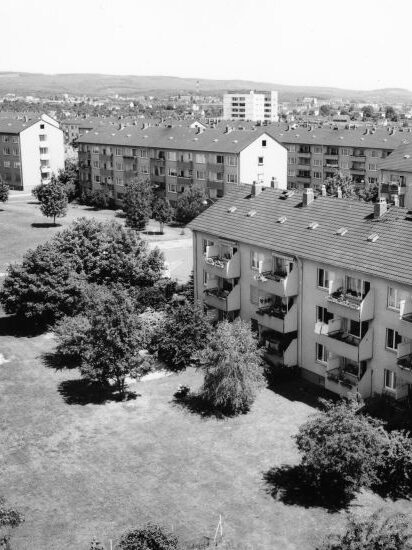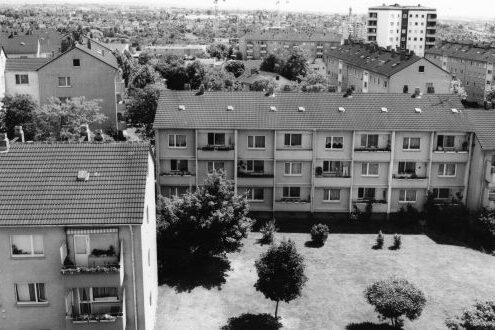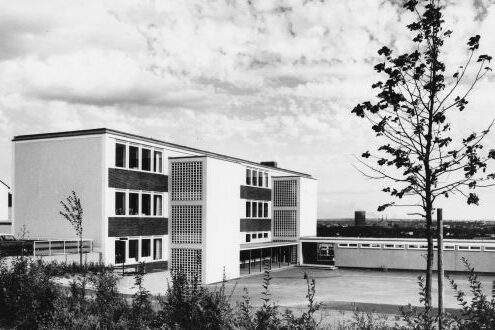Gräselberg
The construction of the new Gräselberg housing estate at the end of the 1950s was intended to help alleviate the housing shortage in Wiesbaden. The first tenants were able to move into their new apartments here in 1960.
The Gräselberg settlement is part of the Wiesbaden-Biebrich district. It is Wiesbaden's oldest and largest "satellite town". Almost 6,000 people live on the approx. 150 meter high elevation in the triangle of Erich-Ollenhauer-Straße, the A 66 freeway, formerly the "Rhein-Main-Schnellweg", and the A 643 (extension of Schiersteiner Straße) on the way across the Rhine to Mainz.
Although the large settlement "Gräselberg" has only existed for half a century, finds show that people settled on the fertile farmland as early as the Neolithic period. Remains of a "villa rustica" from the second half of the second century AD indicate that the Romans also knew how to use the land.
The location "Gresel, Kreßel, Cressel, Größel", which means "sandy place on a hill", is mentioned in a 15th century inventory book of the Tiefenthal monastery. The monasteries of Eberbach and Klarenthal(Klarenthal Monastery) also owned property here. From the Middle Ages until the 19th century, the monasteries used the south-facing sloping terrain for viticulture. The area was also used for sand pits and brickworks. At the confluence of the ancient Rhine and the ancient Main, yellow Main sand was mixed with white Rhine sand and could thus be used for the construction industry in Wiesbaden.
In the 1920s, the first two housing estates were built on the Gräselberg: the Gräselberg housing estate, which was mainly built by streetcar workers on a self-help basis, and the Kurt Albert housing estate for employees of the chemical plant (Chemische Werke Albert). In keeping with the political mood at the time, caused by the French occupation, the streets were named after well-known "freedom fighters" such as Andreas Hofer, Lützow, von der Tann, Schill and Sickingen. During the Second World War, the hill was used as an anti-aircraft position to protect the city of Wiesbaden against attacking Allied bomber planes.
It was not until the 1950s that a completely new start was made. Wiesbaden's first large housing estate was to be built on the still vacant fields, meadows and gardens. The construction had become necessary because more and more people - displaced persons and refugees - had come to Wiesbaden after the Second World War and there was a great housing shortage in the city as a result. The first plans for the new housing estate were drawn up in 1953/54. The purchase of the site began in 1955. In June 1957, the city officially announced the construction project. After completion of the preliminary planning, the first (motorized) ground-breaking ceremony was held on 26 November 1959 by the Hessian Minister of the Interior Heinrich Schneider and the Mayor of Wiesbaden Georg Buch. This ground-breaking ceremony marked the start of a DM 30 million project on an area of 170,000 square meters.
The first 1,200 apartments were ready for occupancy in the fall of 1960. The housing associations Nassauische Heimstätte in Frankfurt and Wiesbaden's Geno50 had created a "residential city in the countryside". It was a mixture of multi-storey apartments, detached houses and two high-rise buildings (1961 and 1962).
In the early 1960s, Südwestdeutsche Gemeinnützige Wohnungsbau AG built company housing for postal workers and Dyckerhoff-Zementwerke(Dyckerhoff GmbH) built company housing for its employees. The proportion of owner-occupied apartments, particularly in the housing estates built on Erich-Ollenhauer-Strasse since 1972 (here another 1000 residential units were built in four to 17-storey buildings), accounts for around ten percent. In 1964, 5000 people were already living on the Gräselberg.
In 1970, two brickworks were closed down for the expansion of a further 1100 residential units; in 2007, a new development area for 150 to 250 residential units was designated in the "Eichen" district between Karawankenstraße and the A 643. The streets were named after Wiesbaden's twin town of Klagenfurt and its alpine surroundings.
While in the early years it was mainly members of the middle class who moved to Gräselberg, the composition of the residents changed over time.
Migrants from all over the world moved to Gräselberg. At over 40%, their proportion is above the Wiesbaden average (around 30%), even if immigrants do not dominate the cityscape as they do in the Inner Westend. The disputes surrounding the construction of a mosque (mosques) in 2006 and 2007 have shown that there are certain social tensions. Nevertheless, Gräselberg is much better from a social point of view than its residents perceive it to be.
In the early years of the new settlement, the lack of amenities, in particular a school and kindergartens, was criticized. The schoolchildren had to attend schools in the neighboring districts. In several town meetings, bus connections were established and a supply center with a pharmacy, hairdresser and "Konsum" was set up. In 1964, the Ludwig Beck School was finally completed. The Friedrich-Bodelschwingh-School for the physically disabled (special schools) was added in 1985.
In addition to the Protestant Lukas parish, founded on May 1, 1963, and the Catholic St. Hedwigs parish, founded on July 10, 1964, Gräselberg is also home to the Free Evangelical parish, the Mormon parish and the Muslim Milli Görus parish.
The Gräselberg Sports Club was founded in 1963 and plays its matches on its own sports field. On Erich-Ollenhauer-Straße is the clubhouse of the Biebrich 1864 e.V. shooting club with a shooting range. Since 1970, the Kalle-Bad has been an attraction not only for local residents, but for the whole of Wiesbaden. The Gräselberg district center looks after children and young people throughout the week. The district store in the Neue Mitte is a meeting center with integration offers for the residents. The "Forum Gräselberg", an association of committed citizens, tried to awaken and strengthen the sense of togetherness among the people of Gräselberg. However, its goal of establishing a community center has not yet been realized.
Literature
Gräselberg, Wiesbaden 2004.


